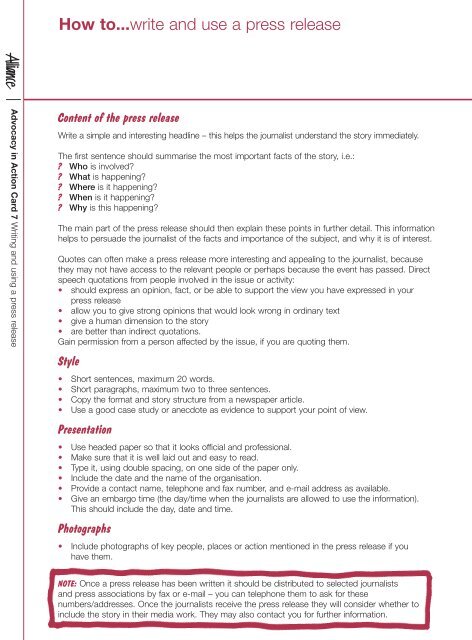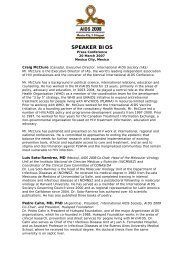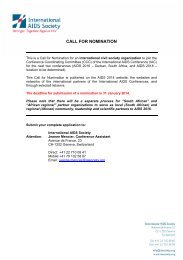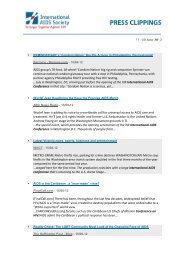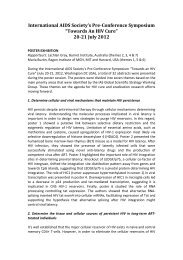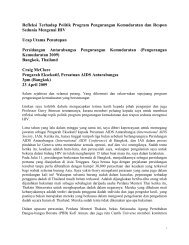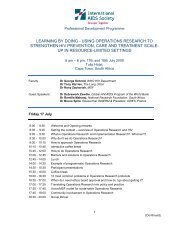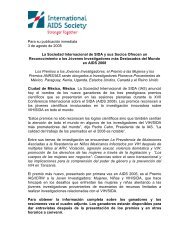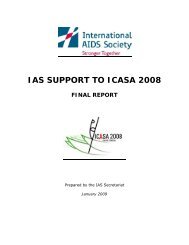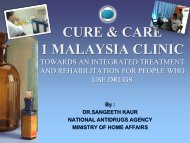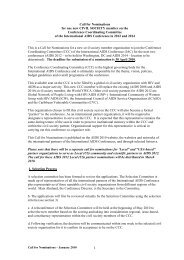Advocacy in Action - International AIDS Society
Advocacy in Action - International AIDS Society
Advocacy in Action - International AIDS Society
You also want an ePaper? Increase the reach of your titles
YUMPU automatically turns print PDFs into web optimized ePapers that Google loves.
How to...write and use a press release<br />
<strong>Advocacy</strong> <strong>in</strong> <strong>Action</strong> Card 7 Writ<strong>in</strong>g and us<strong>in</strong>g a press release<br />
Content of the press release<br />
Write a simple and <strong>in</strong>terest<strong>in</strong>g headl<strong>in</strong>e – this helps the journalist understand the story immediately.<br />
The first sentence should summarise the most important facts of the story, i.e.:<br />
? Who is <strong>in</strong>volved?<br />
? What is happen<strong>in</strong>g?<br />
? Where is it happen<strong>in</strong>g?<br />
? When is it happen<strong>in</strong>g?<br />
? Why is this happen<strong>in</strong>g?<br />
The ma<strong>in</strong> part of the press release should then expla<strong>in</strong> these po<strong>in</strong>ts <strong>in</strong> further detail. This <strong>in</strong>formation<br />
helps to persuade the journalist of the facts and importance of the subject, and why it is of <strong>in</strong>terest.<br />
Quotes can often make a press release more <strong>in</strong>terest<strong>in</strong>g and appeal<strong>in</strong>g to the journalist, because<br />
they may not have access to the relevant people or perhaps because the event has passed. Direct<br />
speech quotations from people <strong>in</strong>volved <strong>in</strong> the issue or activity:<br />
• should express an op<strong>in</strong>ion, fact, or be able to support the view you have expressed <strong>in</strong> your<br />
press release<br />
• allow you to give strong op<strong>in</strong>ions that would look wrong <strong>in</strong> ord<strong>in</strong>ary text<br />
• give a human dimension to the story<br />
• are better than <strong>in</strong>direct quotations.<br />
Ga<strong>in</strong> permission from a person affected by the issue, if you are quot<strong>in</strong>g them.<br />
Style<br />
• Short sentences, maximum 20 words.<br />
• Short paragraphs, maximum two to three sentences.<br />
• Copy the format and story structure from a newspaper article.<br />
• Use a good case study or anecdote as evidence to support your po<strong>in</strong>t of view.<br />
Presentation<br />
• Use headed paper so that it looks official and professional.<br />
• Make sure that it is well laid out and easy to read.<br />
• Type it, us<strong>in</strong>g double spac<strong>in</strong>g, on one side of the paper only.<br />
• Include the date and the name of the organisation.<br />
• Provide a contact name, telephone and fax number, and e-mail address as available.<br />
• Give an embargo time (the day/time when the journalists are allowed to use the <strong>in</strong>formation).<br />
This should <strong>in</strong>clude the day, date and time.<br />
Photographs<br />
• Include photographs of key people, places or action mentioned <strong>in</strong> the press release if you<br />
have them.<br />
NOTE: Once a press release has been written it should be distributed to selected journalists<br />
and press associations by fax or e-mail – you can telephone them to ask for these<br />
numbers/addresses. Once the journalists receive the press release they will consider whether to<br />
<strong>in</strong>clude the story <strong>in</strong> their media work. They may also contact you for further <strong>in</strong>formation.


